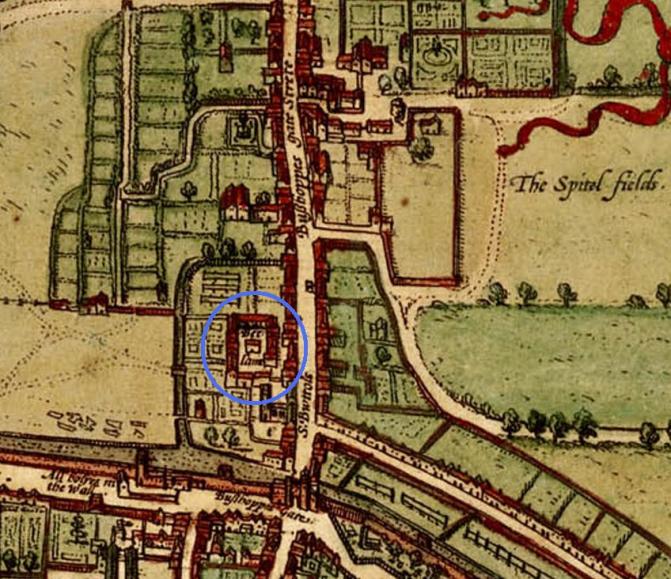
A farthing token issued in the name of James Reddall of the Plough in Bedlam, Bishopsgate Without, London
The above copper farthing token measures15.7 mm and weighs 1.17 grams. It was issued in the name of James Reddall, a tradesman operating from the sign of the plough in Bedlam, Bishopsgate Without, London.
The design of the token may be formally described as follows;
Obverse: (star) IAMES. REDDALL. AT , around the depiction of a swing plough facing left.
Reverse: (star) THE. PLOW. IN. BEDLAM, around a twisted wire inner circle, within a triad of initials comprising I | .R. | .S with a dot below the “R”
Based on the style of this token it probably dates to the period 1650 to 1660.
The issuing location of this token was the district of Bedlam in the Bishopsgate Ward of the city.
Bedlam was a colloquial name given to Bethlem, a 13th century priory church founded by the Italian bishop-elect of Bethlehem to raise alms and funds to support the crusades to the Holy Land. It was located just north of St. Botolphs Parish Church off Bishopsgate Street outside the city walls. By 1330 Bedlam was more often referred to as a hospital which in medieval terms may have simply denoted a hostel for travelling alms-seekers. By the 1370s the hospital had been seized by the crown and was becoming a far more secularized institution. It was from this period that it became first associated with the care of the mentally ill. So was to begin a centuries long tradition for which the institute and its later nearby successor was to became famous throughout Europe.

Detail from a map of Elizabethan London (1572) taken from “Civitates orbis terrarum” showing the location of Bethlem Hospital in the Bishopsgate Without Ward of the city
Although Bethlem had been enlarged by 1667 to accommodate fifty nine patients, the Court of Governors of the hospital observed at the start of 1674 that;
“The Hospital House of Bethlem is very old, weak & ruinous and to small and streight for keeping the greater number of lunatics therein at present.”
Given the increasing demand for admission and the inadequate and dilapidated state of the building it was decided to rebuild the hospital on a site at nearby Moorfields, which was just north of the city walls and one of the largest open spaces in London. The architect chosen for the new hospital, which was built rapidly and at great expense between 1675 and 1676, was the famous natural philosopher and City Surveyor Robert Hooke.

Engraving by Robert White of the new Bethlem Hospital designed by Robert Hooke and built at Moorfields, outside of the City of London in 1676
By the late 1670s the original site and any remaining buildings which had once comprised part of the original Bethlem Hospital had been absorbed by the wide spread urban development to the west of Bishopsgate Street Without. Today nothing remains of the medieval hospital. Its former site is now occupied by the Great Eastern Hotel next to Liverpool Street Railway Station.
The reverse of the token bears a triad of issuers’ initials, i.e. those of James Reddall and his wife. The appearance of “I” for “J” for “James” can be explained by the use of Latin script in which Js are represented by Is. At the time the token was issued we can assume that James wife’s Christian name was Sarah, Susan or similar.
I have been unable to find any conclusive evidence of where and when the primary issuer of this token was born, married or buried. However, he could well be one or all of the following individuals both of whom lived in the Parish of St. Botolphs in Bishopsgate Without, this being the token issuer’s local church;
1) James Reddall – married Judith Finch on 26th September 1661 (extracted from the parish registers of Holy Trinity Church, Minories, London).
2) James Reddall – buried on 22nd February 1684/5 at St. Botolphs, Bishopsgate Without.
A further examination of the parish registers of St. Botolphs in Bishopsgate Without indicate the following children being born to a James and Judith Reddall;
1) Thomas – christened on 8th September 1661
2) Elizabeth – christened on 24th January 1663/4
3) Finch – christened on 26th March 1664/5 (Finch apparently being taken from the mother’s maiden name)
A further reference to a James Reddall can be found in the Hearth Tax returns of 1662 for the first western precinct of the Bishopsgate Ward. He is recorded as occupying a property with 6 hearths.
Based on the information on his token James Reddall’s occupation can’t be certain but it is clear that he traded from or near to the sign of the plough in Bedlam. In London the sign of the plough was adopted from the 16th century onwards by several taverns but was by no means exclusive to that trade.


Hi I have been researching a token with a half moon cresent in the centre of one side and the text -the sign of the half (perhaps the half moon brewers) on the other side the init also in the centre T B with a flower the same as this token in between. Around the outsidetails in reads something then In bedlam with the same weave sort of pattern is can’t help but feel this token is connected. I hope to hear fromantic you. Regards donna
LikeLiked by 1 person
Hello Donna
Unfortunately I’m working overseas at the moment and have not got easy access to my reference books. I’ll try and get back to you as soon as I can.
LikeLike